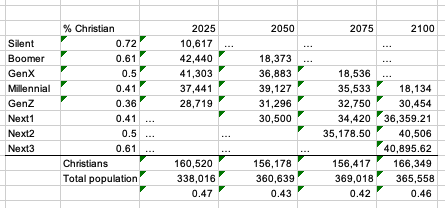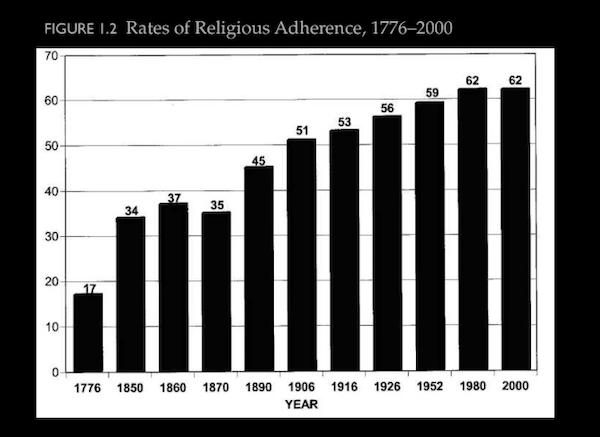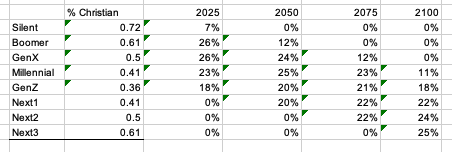Missionary Attrition
08 Dec 2023USA generational change and population decline
Dec 1
New projections from the US Census Bureau forecast a shrinking population after 2080 unless immigration increases. In what they deem the most likely scenario, the US population will rise from today’s 335 million to 370 million in 2080, then decline to 366 million by 2100. (Without any immigration, the country’s population would begin to decline almost immediately.)
Such a very long-term population forecast is subject to all the possibilities of change between now and then–that time period encompasses all the people alive today plus at least three new generations. Still, it’s helpful to examine this scenario to consider all the things that will happen along the way, some of which will happen to us.
The two driving forces behind this scenario are decreases in birth rates and changes in immigration patterns. A declining birth rate and an unchanging death rate means the country as a whole will age–the older ‘cohorts’ will be larger than the younger ‘cohorts.’ The current forecast is for the number of people 65 years or older to outnumber children under 18 by 2029. By 2050, there will be almost as many people in the 60-to-80 bracket as in the 0-to-20 bracket.

Population in 20-year age brackets, in thousands.
Comparisons in a single year (e.g. 2025) shows us the difference in size of these 20-year brackets. But comparing between two periods, we see the shifts in generations. The following chart shows the ‘aging’ of the generations through the years–we begin to see the huge shift that is coming.

The next 25 years will obviously see a massive shift. (I realize not everyone will agree with the generational years I’ve outlined here, but they are ‘roughly’ right and fit the 20-year cohorts in the census data. I generally disagree with a 1985-95 birth year range for Millennials.) In 2025 the ‘Silent’ (pre-Boomer) generation will be 80 to 100 years old; by 2050, they will be completely gone (except for perhaps a handful of centenarians). Boomers are now roughly 60 to 80 years old now–by 2050, they will be in their 80s and 90s, and largely gone or going as well. (Cue analyses of generational transfer of wealth here.) In 2050, Xers like myself will be headed into retirement (or second careers? boards of directors, etc?) and Millennials will be in middle-age and thinking about retirement. These shifts, plus hints of future unnamed generations here:

What does this imply for the church in America, and in particular for the mobilization of new missionaries and the funding of missions?
We know Christianity in general is declining in America. In 2019, Pew noted it had fallen to 65%, and was continuing down. Regular church attendance was/is declining too: in 2019, 45% attended monthly, and Barna estimated weekly attendance at 29%.
We know there is a generational element to this decline. I don’t have granular enough data to track the rate of decline in each generation over the past fifty years, but we know certain generations are more professedly Christians, and others less. Since the ‘Silents,’ each generational cohort has been progressively less religious than the last (see analysis by Ryan Burge). So, we can use this to sort of extrapolate a ‘future’ of Christianity, insofar at least as the generational dynamic goes:

This is a pretty grim scenario. By this, Christianity would have the appearance of being one-quarter of the country by 2100. But there are some important caveats. First, Burge’s work only estimates %s for adults, so the total Christian picture is undercounted. Population projections as far out as 2075 and 2100 are obviously very fragile, ephemeral things. This also presumes that the % Christian of each of these groups remains the same–but a Fourth Turning analysis suggests another Awakening scenario is likely somewhere between 2050 and 2070. Finally, this only includes the five generations presently in view. Their spiritual dynamic could be very different. Let’s assume a 2050-2070 Awakening ‘reversed’ the spiritual decline, and later generations were more religious, not less (as has happened in America’s history):

In this scenario, a 2050-2075 Awakening ‘reverses the spiritual tendencies’ for the Next1, Next2, and Next3 generations. This sort of event would seem to stabilize Christianity. Is this realistic? Suffice for the moment to say that America’s history has not been one of a progressive fall in % Christian. Consider the research of Rodney Stark, in The Churching of America:

In the meantime, however, the important part of this analysis is the generational shift in Christianity. Between now and 2050, Silents will fade from Christianity, and Boomers will represent only 12% of Christians in America. A generational transfer will occur, and any existing church that is made up of mostly Silents or Boomers will meet a moment of reckoning. Any organization whose donor base is now primarily made up of Silents and Boomers will face significant challenges over the next 25 years.

We know churches are already closing. A 2020 survey by Faith Communities Today estimated there are between 350k and 375k congregations in all faith traditions in America, of which 70% had less than 100 weekly attendees and 44% had less than 50. A tenth (~35k churches) have “more than 250 attendees”—some, significantly more than 250 attendees: 70% of all regular attendees are in these 35k churches. With the average church building having capacity for 200 people, “half of all congregations have no more than 38% of their seats occupied during weekend services.” If half of the churches in America have fewer than 50 worshippers weekly, how sustainable is that? (Especially if those worshippers are largely Silents and Boomers with a handful of Xers thrown in.)
The close/open rates are not systematically reported, but a Lifeway Research project in 2020 estimated that yearly over 4,500 Protestant churches closed while just 3,000 new ones were started—a net loss of 1,500 churches, or 0.4% of the total. While I have little available research, I hypothesize the new church efforts are being planted in places and with strategies designed for larger congregations. I suspect that the “70% of all regular attendees are in these 35k congregations” are in larger congregations, and a significant portion of Millennial and GenZ believers are among those. In the religious market today, no one is trying to plant a church that would stay around 100 (at least, amongst Protestants, who aim for a congregational rather than a parish strategy).
If your fundraising systems depend on small churches, or older donors, I suspect you should consider these numbers carefully, and ponder what shifts have to happen in the next 2 to 5 years to survive the next 10 to 20.